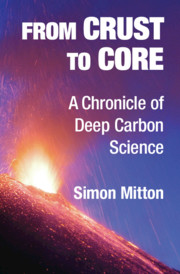Book contents
- From Crust to Core
- From Crust to Core
- Copyright page
- Dedication
- Contents
- Foreword
- Acknowledgments
- Introduction
- 1 Why Carbon in Earth Matters
- 2 The Origin of Deep Carbon in Deep Space
- 3 Deliveries of Cosmic Carbon Continue
- 4 On the Nature of Earth’s Interior
- 5 Earth’s Physical Interior Revealed
- 6 Thousands, Millions or Billions
- 7 Physics and Chemistry of Deep Earth
- 8 Confronting the Continental Drift Conundrum
- 9 The Mid-Atlantic Ridge and Rift Valley
- 10 Earth’s Deep Dynamics Discovered
- 11 Reversals of Fortune
- 12 Deep Carbon
- 13 Carbon-Bearing Phases in the Mantle
- 14 Diamond in the Mantle
- 15 Deep Life
- Glossary
- Biographical Notes
- Index
Introduction
Published online by Cambridge University Press: 19 December 2020
- From Crust to Core
- From Crust to Core
- Copyright page
- Dedication
- Contents
- Foreword
- Acknowledgments
- Introduction
- 1 Why Carbon in Earth Matters
- 2 The Origin of Deep Carbon in Deep Space
- 3 Deliveries of Cosmic Carbon Continue
- 4 On the Nature of Earth’s Interior
- 5 Earth’s Physical Interior Revealed
- 6 Thousands, Millions or Billions
- 7 Physics and Chemistry of Deep Earth
- 8 Confronting the Continental Drift Conundrum
- 9 The Mid-Atlantic Ridge and Rift Valley
- 10 Earth’s Deep Dynamics Discovered
- 11 Reversals of Fortune
- 12 Deep Carbon
- 13 Carbon-Bearing Phases in the Mantle
- 14 Diamond in the Mantle
- 15 Deep Life
- Glossary
- Biographical Notes
- Index
Summary
My engagement with the new field of deep carbon science began in September 2015, when Marie Edmonds of the Department of Earth Sciences at the University of Cambridge asked if I would be interested in researching a history of deep carbon science. By then I had been working in the history of science for some 15 years, following early retirement from Cambridge University Press. Much of my academic activity had been limited to the history of astronomy and cosmology in the twentieth century. In the geosciences, my knowledge of its pioneers was more or less limited to what had been achieved by people in Cambridge, particularly in tectonics, which was centre stage when I commenced my doctoral research at the Cavendish Laboratory in the radio astronomy group that had discovered pulsars. Over a working lunch at Queen’s College, Marie told me about the exciting multidisciplinary mission of the Deep Carbon Observatory (DCO). I was immediately attracted by the vast transformative scope of this large-scale research programme with its focus on four clearly defined themes to be undertaken by four scientific communities working collegially. Through this framework the DCO had already completed six years of comprehensive exploration of deep carbon in Earth’s crust, mantle and core. By this point in our conversation I was beginning to wonder how on Earth I could have anything to offer, given that my limited experience as a historian of science had been all about the pioneers who looked up in wonder at the mechanism of the heavens. So I was delighted to receive an invitation to participate as a historian of science at a DCO planning meeting soon to be held in a rural retreat at the University of Rhode Island in late 2015.
- Type
- Chapter
- Information
- From Crust to CoreA Chronicle of Deep Carbon Science, pp. 1 - 3Publisher: Cambridge University PressPrint publication year: 2020

